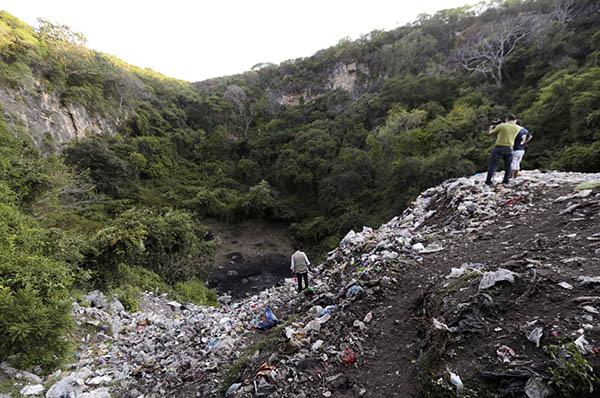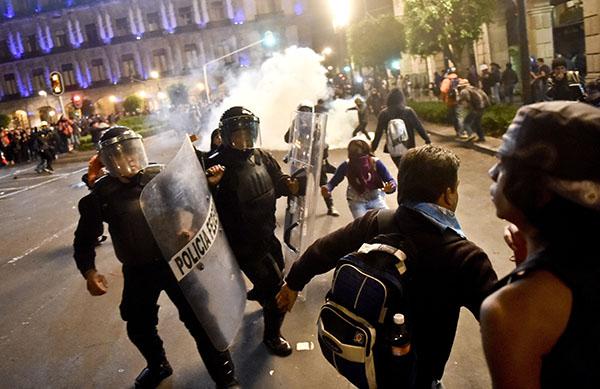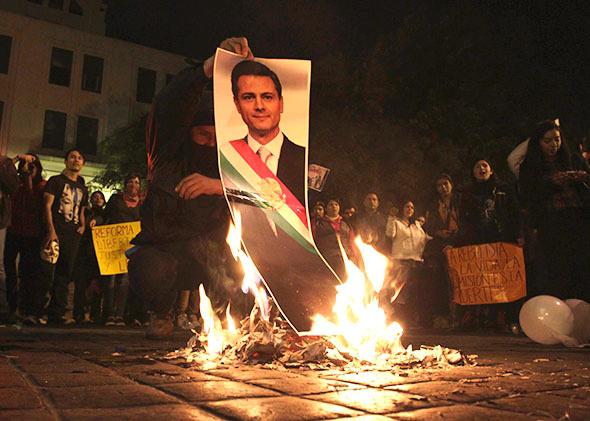Mexican President Enrique Peña Nieto is meeting with President Obama at the White House on Tuesday. Even under normal circumstances, trade, energy, and immigration issues would give the two leaders more than enough to talk about, and these are certainly the subjects Peña Nieto would prefer to have on the agenda.
But the big question going into the meeting is whether and how the presidents will address the ongoing controversy over the Mexican government’s handling of the disappearance of 43 students from Ayotzinapa, in the southwestern state of Guerrero. The suspected involvement of local authorities along with drug cartels in the students’ disappearance last September—as well as the Mexican government’s ineffectual response—has prompted massive protests across Mexico, as well as some in the United States.
The case has deeply affected Peña Nieto’s public approval, which is at its lowest in his two-year presidency–lower than that of his predecesors, Vicente Fox and Felipe Calderón, and the lowest for any Mexican president in nearly 20 years. The U.S. government—the primary foreign backer of the Mexican government’s drug war— has been generally hesitant to weigh in on the case, though the State Department has faced questions over whether it will review Mexico’s human rights standing.
But what could be the most damaging blow to Peña Nieto’s administration came last month. An investigation conducted by the Mexican magazine Proceso with support from the Investigative Reporting Program at the University of California at Berkeley claimed to confirm the Mexican military’s and federal government’s direct involvement in the disappearance of the 43 students.
The investigation from Proceso is based on more than 900 pages of official documents, on recently uncovered video from the attack and on student testimonies. It contradicts the government’s version of events, that this was a strictly local issue of corruption and collusion with drug gangs. According to the official version, on the night of Sept. 26, Iguala and Cocula police, without the federal government’s knowledge and under orders from the mayor of Iguala, attacked the students, killing three of them and delivering the other 43 to the local drug gang, Guerreros Unidos, who murdered them before incinerating their bodies at a nearby dump.
It took the attorney general’s office eight days to agree to investigate the case, after multiple requests from the students’ families and the press, and it only did so when it became known that organized crime, Guerreros Unidos, had been involved. But according to a previously unpublished report from the state of Guerrero dating back to October and that was delivered to the Ministry of Interior more than a month ago, federal forces not only already knew what had happened—they had been monitoring the students’ movements since they left Ayotzinapa that night and were waiting for them when they arrived at Iguala, where they participated in the attack. In cellphone videos of the attack, someone can be heard saying, “The police are leaving, the Feds are going to stay and try to bother us.”
Then, after more than a month of being involved in the investigation, Attorney General Jesús Murillo Karam announced at a press conference on Nov. 7 that three members from Guerreros Unidos had confessed to murdering and burning the students and had testified against the mayor of Iguala, José Luis Abarca, and against the Iguala and Cocula police. But according to documents from the attorney general’s office obtained by Proceso, at least five of these gang members had been tortured by marines and federal police putting their testimonies in question.
Federal Police Commissioner Enrique Galindo denied any involvement from federal authorities, as did Murillo Karam during an interview with CNN en Español on Dec. 16. He stated federal police did know the students were traveling to Iguala, but denied any participation in the attack or having received a report from the government of Guerrero on allegations of torture, even though Proceso found medical opinions carried out by the attorney general’s office where the abuses are thoroughly documented. Only after the Proceso investigation was published did Murillo Karam admit there had been federal officers present in Iguala, contradicting his earlier statements from November.
But perhaps the most unequivocal and damaging evidence against the government’s narrative comes from scientists at the National Autonomous University of Mexico, or UNAM, who put together a report that claims the government’s official narrative “has no basis in scientific fact.” To cremate 43 bodies, a space 10 times as large as the Cocula dump would’ve been necessary, as well as 33 tons of tree trunks 4 inches wide, equivalent to two trailer trucks full of wood. If they had used fuel, 117 pounds of fuel per body would’ve been needed, burning for eight days straight. If tires had been used, they would’ve needed 995 passenger car tires, burned at least 2,597 degrees, which would’ve left behind two and a half tons of steel wire and a column of smoke visible for several miles.

The garbage dump where remains were found outside Cocula, near Iguala November 7, 2014.
Photo by Henry Romero/Reuters
José Antonio Montemayor, head researcher at the Physics Institute at UNAM, told Univision that government officials are mocking the country by “creating a fantasy.”
“When we say it’s impossible, we’re not playing around,” Montemayor said, “We’re aware of the seriousness of the situation.”
This opens up a lot of questions regarding the entire investigation (on which the FBI has collaborated), and particularly about the only body that has been identified so far. One of the 43 students’ identities was confirmed by DNA tests run by Argentinian forensic experts. But they stressed they can’t confirm if the body comes from the Cocula mass grave since they weren’t present when that body bag was recovered, a statement that has helped stoke the controversy.
Peña Nieto’s handling of the case has only made matters worse. The Mexican president warned several times ahead of the Nov. 20 protests in Mexico City that the authorities would be well within their rights to use force against any attempts to “destabilize, generate social disorder and above all, in attacking the national project we’ve been constructing.” Seemingly acting on those warnings, federal police arbitrarily arrested and brutally beat 20 protesters and bystanders during the protests. Detainees were charged with criminal conduct, rioting, and manslaughter, held in isolation, and transferred to maximum-security federal prisons with abhorrent human rights records. They were released 10 days later with no charges for a lack of evidence. According to some of those detained, the police abused them and threatened to burn them alive—a clear reference to the Ayotzinapa students.

Photo by Yuri Cortez/AFP/Getty Images
In light of all of these compounded events, and after a violent clash last month between federal police and teachers and family members of the Ayotzinapa students who were protesting in Chilpancingo, the capital of Guerrero, the students’ parents suspended dialogue with the government. Though the government is maintaining its version of the events, their credibility has all but vanished.
What precisely was the government’s role on the night the 43 students disappeared is still unknown. President Obama should take Peña Nieto’s visit as an opportunity to ask.
Special thanks to Humberto Beck for assistance on this post.
Also in Slate, how the disappearance of the Ayotzinapa students transformed protesting in Mexico.
